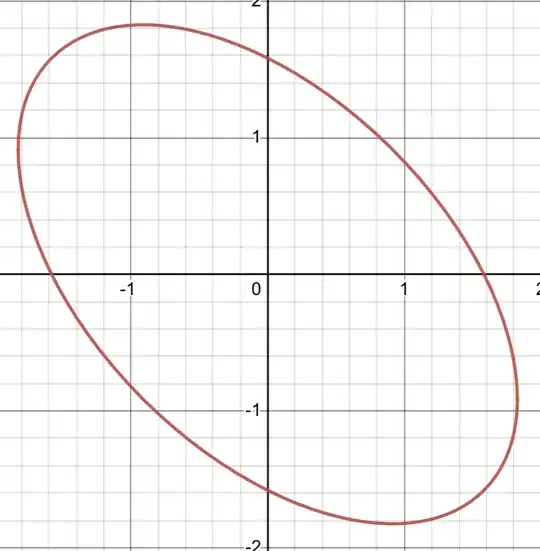This is how the rotated ellipse looks like, according to Desmos:

Apparently the ellipse is rotated by $-\frac \pi4$, if the long axis was horizontal. However, if the long axis was vertical then the ellipse is rotated by $\frac \pi4$.
The coordinates of a point on the rotated ellipse are
$$(x_r,y_r)=(x\cos \theta-y\sin \theta,x\sin \theta+y\cos \theta)$$
The given equation of the rotated ellipse is:
$$\begin{align}&2x^2_r+2y^2_r+2x_ry_r=5\\ &\Leftrightarrow 2(x\cos \theta-y\sin \theta)^2+2(x\sin \theta+y\cos \theta)^2+2(x\cos \theta-y\sin \theta)(x\sin \theta+y\cos \theta)=5\\&\Leftrightarrow 2x^2(1+\cos \theta\sin\theta)+2y^2(1-\cos \theta \sin\theta)+2xy\underbrace{(\cos^2\theta-\sin^2\theta)}_{=0}=5\\&\Leftrightarrow\boxed{\frac{x^2}{\frac 5{2(1+\frac{\sin 2\theta}2)}}+ \frac{y^2}{\frac 5{2(1-\frac{\sin 2\theta}2)}}=1, \cos^2\theta=\sin^2\theta}\end{align}$$
Two solutions are possible depending on the solution of $\cos^2\theta=\sin^2\theta$:
$$\begin{align}\cos^2\theta=\sin^2\theta&\Rightarrow \cos\theta=\sin\theta\\&\Rightarrow \theta=\frac \pi4+k\pi, k\in \Bbb Z\\&\Rightarrow a^2=\frac 53, b^2=5\text{ : long axis is vertical}\end{align}$$
I would not consider an ellipse with long axis vertical because the rotation is presumed to come off a standard position where the original ellipse was centered in origin with the long axis horizontal.
$$\begin{align}\cos^2\theta=\sin^2\theta&\Rightarrow \cos\theta=-\sin\theta\\&\Rightarrow \theta=\frac {3\pi}4+k\pi, k\in \Bbb Z\\&\Rightarrow a^2=5, b^2=\frac 53\text{ : long axis is horizontal}\end{align}$$
